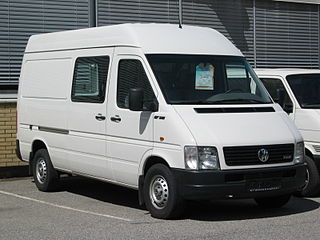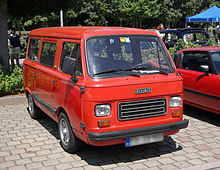
A pickup truck or pickup is a light or medium duty truck that has an enclosed cabin, and a back end made up of a cargo bed that is enclosed by three low walls with no roof. In Australia and New Zealand, both pickups and coupé utilities are called utes, short for utility vehicle. In South Africa, people of all language groups use the term bakkie; a diminutive of Afrikaans: bak, meaning bowl or container.

The Fiat 128 is a transverse front-engine, front wheel drive small family car manufactured and marketed by Fiat from 1969 to 1985 as a two- or four-door sedan, three- or five-door station wagon as well as two- or three-door coupé. The 128 running gear and engine, reconfigured for a mid-engined layout, were used in the Fiat X1/9 sports car.

The Fiat 500 is an economy / city car that was manufactured and marketed by Fiat Automobiles from 1957 until 1975. It was sold as a two-door semi-convertible or saloon car and as a three-door panel van or estate car.

The Volkswagen Type 2 is a forward control light commercial vehicle introduced in 1950 by the German automaker Volkswagen as its second car model. Known officially as the Transporter, Kombi or Microbus, or, informally, as the Volkswagen Station Wagon (US), Bus, Camper (UK) or Bulli (Germany), it was given the factory designation Type 2 as it followed – and was initially derived from – Volkswagen's first model, the Type 1 (Beetle).

The Volkswagen Transporter (T4), marketed in North America as the Volkswagen EuroVan, is a van produced by the German manufacturer Volkswagen Commercial Vehicles between 1990 and 2004, succeeding the Volkswagen Type 2 (T3) and superseded by the Volkswagen Transporter (T5).

A campervan, also referred to as a camper, caravanette, motorhome or RV in North America, is a self-propelled vehicle that provides both transport and sleeping accommodation. The term describes vans that have been fitted out, whereas a motorhome is one with a coachbuilt body.

The Volkswagen Caddy is a panel van and leisure activity vehicle (M-segment) produced by the German automaker Volkswagen Group since 1980. It is sold in Europe and in other markets around the world. The Volkswagen Caddy was first introduced in North America in 1980 and in Europe in 1982. The first and second generations also had pick-up variants.

The Volkswagen LT is the largest light commercial panel van produced by Volkswagen from 1975 to 2006, before being replaced by the Crafter. Two generations were produced.

The Volkswagen Type 2 (T3) was the third generation of the Volkswagen Transporter and was marketed under various nameplates worldwide – including the Transporter or Caravelle in Europe, T25 in the UK, Microbus and Kombi in South Africa/Brazil/Australia, Kampeerauto in Netherlands, Combi in France and Vanagon in North and South America.

The GAZelle is a series of light commercial vehicle—pickup trucks, vans and minibuses—made by Russian car manufacturer GAZ. At the time of the dissolution of the Soviet Union and transition to a market economy, the Russian automobile industry had not produced a much-demanded LCV similar to the Ford Transit or VW T4 class. The GAZelle shares many parts with the company's passenger cars ; in fact, models produced until 1998 had the same grille. Riga Autobus Factory, which formerly manufactured minibuses for the whole USSR, remained in Latvia, and now required its vehicles be sold to the now-foreign Russian market for hard currency. Responding to this market opportunity, GAZ swiftly developed its own LCV called GAZelle, which, taken together with its lighter version, Sobol, now account for the majority of the Russian van and light truck market and have strong positions in the markets of other CIS countries, ranking as GAZ's most popular and successful products.

The Fiat 600 is a small, rear-engined city car and economy family car, made by Italian carmaker Fiat from 1955 to 1969 — offered in two-door fastback sedan and four-door Multipla mini MPV body styles. The 600 is considered a pop icon of the Italian economic miracle, and the three-row seating Multipla, though diminutive and odd-looking, is seen as one the first mass-produced minivans.

The Citroën H-Type vans, are a series of panel vans and light trucks, produced by French automaker Citroën for 34 years – from 1947 through 1981. They are notable for their industrial design, using many corrugated metal outer body panels to save material, weight, and costs. Early models of the uniquely styled trucks were just named Type H, but soon they were differentiated by a second letter, using the last four letters in the alphabet – except for the type HP for (flat-bed) pickups. Thus the vans were built as the types HW through HZ – with the majority of them built as Citroën HY.

The FSO Polonez is a motor vehicle that was developed in Poland in collaboration with Fiat and produced by Fabryka Samochodów Osobowych from 1978 to 2002. It was based on the Polski Fiat 125p platform with a new hatchback design by Zbigniew Watson, Walter de Silva and Giorgetto Giugiaro. It was available in body styles that included two- and four-door compact-sized cars, station wagons, as well as commercial versions as pickup truck, cargo van, and ambulance. Production totaled more than one million units, excluding the pickup truck and van variants. The Polonez was marketed in other nations and was popular in its domestic market until Poland joined the European Union in 2004.

The Fiat Fiorino is a small commercial vehicle produced by the Italian car manufacturer Fiat since 1977. Its first two generations have been the panel van derivatives of other small models, such as the Fiat 127 and Fiat Uno, while the current third generation was developed jointly with PSA Peugeot Citroën, and is based on the Fiat Small platform.

The Toyota HiAce is a light commercial vehicle produced by the Japanese automobile manufacturer Toyota. First launched in October 1967, the HiAce has since been available in a wide range of body configurations, including a minivan/MPV, minibus, panel van, crew van, pickup truck, taxi and an ambulance.
The name Chevrolet Greenbrier was used by Chevrolet for two vehicles. The first vehicles were a six-to-nine-passenger window van version of the Corvair 95 van. The Corvair 95 series also included the Loadside pickup truck and Rampside pickup truck that featured a mid-body ramp on the right side. All used the Corvair powertrain in a truck body and were produced in the model years 1961 to 1965.

The Fiat 850 is a small rear-engine, rear-wheel-drive car manufactured and marketed by Italian car manufacturer Fiat from 1964 to 1973.

The Zastava 750 is a supermini made by the Yugoslav car maker Zavod Crvena Zastava in Kragujevac. It was a version of the Fiat 600 made under licence from 1962 and was somewhat longer than the Fiat version. The Zastava 750 has a 767 cc (46.8 cu in) engine, which produces 25 PS (18.4 kW). The more powerful 750 SE has 30 PS (22.1 kW) at 5400 rpm and torque is 38 lb⋅ft (52 N⋅m) at 3600 rpm. It is the smallest car ever made by Zastava. Later on during production, in 1980, the Zastava 850 was introduced. It is nearly identical to the Zastava 750 but the engine had a larger capacity. The Zastava 850 is harder to find than the 750 model but both are still widely available in former Yugoslavia.

The Iveco Daily is a large light commercial van produced by the Italian automaker Iveco since 1978; it was also sold as the Fiat Daily by Fiat until 1983. Unlike the more car-like unibody Fiat Ducato, the Daily uses a separate ladder frame typical of heavier commercial vehicles. The Iveco Daily is produced at the Iveco Suzzara plant, near Mantova in Italy, where Iveco has recently made substantial investments to renew the production lines.

The Volkswagen Amarok is a pickup truck produced by Volkswagen Commercial Vehicles since 2010. It is a body-on-frame truck with double-wishbone suspension at the front and leaf springs at the rear. The Amarok range consists of single cab and double cab, combined with either rear-wheel drive or 4motion four-wheel-drive, and is powered by turbocharged petrol or turbocharged direct injection (TDI) diesel engines.






















